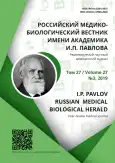Morphological status of students with different level of motor activity
- 作者: Mikhailova S.V.1, Deryugina A.V.2, Syomova S.G.1
-
隶属关系:
- N.I. Lobachevsky National Research State University of Nizhny Novgorod (Arsamas branch)
- N.I. Lobachevsky National Research State University of Nizhny Novgorod
- 期: 卷 27, 编号 3 (2019)
- 页面: 342-352
- 栏目: Original study
- URL: https://journals.rcsi.science/pavlovj/article/view/16342
- DOI: https://doi.org/10.23888/PAVLOVJ2019273342-352
- ID: 16342
如何引用文章
详细
A study of the effect of motor activity on the health condition of students that generalizes peculiarities of the morphological status and of physical development on the whole, permits to identify mechanisms controlling health factors.
Aim. Determination of the peculiarities of the dynamics of morphological status of students with different levels of motor activity in the period of study at aninstitution of higher education (IHE).
Materials and Methods. A prospective study of physical health of 630 students of 17-22 years of age in the period from 2010 to 2018. In students, the body length, body mass, chest circumference and other parameters were measured and the somatotype was determined every year in the period of study at anIHE (5 years).
Results. It was found that in the period of study at anIHE, growth processes continued only in 51.9% of examined boys and gradually terminated at 21-22 years of age, and in 36.9 % of girls with termination at 21-22 years. In most students increment of the body mass and chest circumference was recorded, there were also found boys and girls with these parameters remaining unchanged during period of study at anIHE, and in some cases their decline was found. The increment of the body mass and chest circumference was demonstrated to slow down with termination of growth processes, but did not stop altogether which resulted in increase in the amount of students with excessive weight. This was also facilitated by reduction of the level of motor activity in senior years when physical culture classes are no longer included into the curriculum. The dependence of growth processes in boys and girls at the age of 17-22 years on the level of motor activity was revealed that influenced the speed and direction of increment of the total dimensions of the body and the type of body-build. According to our data, the majority of boys support a high level of motor activity to buildup the body mass, and girls lead an active way of life to decrease the body mass and to keep it on the optimal level.
作者简介
Svetlana Mikhailova
N.I. Lobachevsky National Research State University of Nizhny Novgorod (Arsamas branch)
编辑信件的主要联系方式.
Email: fatinia_m@mail.ru
ORCID iD: 0000-0003-3842-0994
SPIN 代码: 3485-3095
Researcher ID: E-3133-2019
PhD in Biological Sciences, Associate Professor of the Department of Physical Culture
俄罗斯联邦, ArsamasAnna Deryugina
N.I. Lobachevsky National Research State University of Nizhny Novgorod
Email: fatinia_m@mail.ru
ORCID iD: 0000-0001-8812-8559
SPIN 代码: 7974-4600
Researcher ID: Е-7522-2019
Head of the Department of Physiology and Anatomy, Biology and Biomedicine Institute
俄罗斯联邦, Nizhny NovgorodSvetlana Syomova
N.I. Lobachevsky National Research State University of Nizhny Novgorod (Arsamas branch)
Email: fatinia_m@mail.ru
ORCID iD: 0000-0002-2121-2622
SPIN 代码: 4523-4060
Researcher ID: E-3716-2019
Senior Lecturer of the Department of Physical Culture
俄罗斯联邦, Arsamas参考
- Baronenko VA, Rapoport LA. Zdorov'e I fiziches-kaya kul'tura studenta. Moscow: Al'fa-M, INFRA-M; 2012. (In Russ).
- Negasheva MA, Mihajlenko VP, Kornilova VM. Razrabotka normativov fizicheskogo razvitiya yunoshey i devushek 17-18 let. Pediatriya. Zhurnal im. G.N. Speranskogo. 2007;86(1):68-73. (In Russ).
- Khomutov AB. Antropologiya. 3rd ed. Rostov n/D: Feniks; 2004. (In Russ).
- Chekalova NG, Silkin YuR, Matveeva NA, et al. Functional reserves of children. Methods of research and estimation. Nizhny Novgorod; 2010. (In Russ).
- Orlova SV. Zavisimost’ urovnya fizicheskogo zdorov’ya studentov-medikov ot somatotipa. Vestnik RGMU. 2003;2(28):254. (In Russ).
- Mikhaylova SV, Kuzmichev YuG, Zhulin NV. Metody otsenki i samokontrolya fizicheskogo zdorov’ya uchashcheysya molodezhi. Arzamas; 2017. (In Russ).
- Shtefko VG, Ostrovskiy AD. Skhemy klinicheskoy diagnostiki konstitutsional’nykh tipov. Moscow – Leningrad; 1929. (In Russ).
- Darskaya SS. Tekhnika opredeleniya tipov konstitutsii u detey i podrostkov. Otsenka Konstitutsii u Detey i Podrostkov. Moscow; 1975. P. 45-50. (In Russ).
- Rudnev SG, Soboleva NP, Sterlikov SA, et al. Bioimpedance study of body composition in the Russian population. Moscow; 2014. (In Russ).
- Bezrukikh MM, Farber DA, editors. Fiziologiya razvitiya rebenka. Rukovodstvo po vozrastnoy fizio-logii. Moscow – Voronezh; 2010. (In Russ).
- Negasheva MA, Mishkova TA. Anthropometric parameters and adaptive capacities of students by the early 21st century. Russian Pediatric Journal. 2005;(5):11-16. (In Russ).
- Leybovsky AYu, Ivanova NA. The dynamics of indices of physical development, physical and functional readiness of students of Kuban state techno-logical university, the correspondence of investigated parameters to the standard requirements. Physical Culture, Sport – Science and Practice. 2012;(3):59-64. (In Russ).
- Bulich EG, Muravov IV. Zdorov’ye cheloveka: Biologicheskaya osnova zhiznedeyatel’nosti i dvigatel’naya aktivnost’ v eye stimulyatsii. Kiev; 2003. (In Russ).
- Stamova LG, Sikacheva JM. Influence of impellent activity on adaptation to training and health of students. Physical Culture and Health. 2009;(3):15-7. (In Russ).
- Kabachkova AV, Fomchenko VV, Frolova YuS. Students' physical activity. Tomsk State University Journal. 2015;(392):175-8. (In Russ). doi:10.17223/ 15617793/392/29
- Litovchenko OG. Morfologicheskiye i funktsio-nal’nyye pokazateli studentov g. Surguta s vysokoy dvigatel’noy aktivnost’yu. Uspekhi sovremennogo estestvoznaniya. 2003;(11):66-67. (In Russ).
- Rubtsova IV, Kubyshkina TV, Alatortseva EV, et al. Optimal’naya dvigatel’naya aktivnost’. Voronezh; 2007. (In Russ).
- Mikhaylova SV, Polyakova TA, Sidorova TV, i dr. Kharakteristika funktsional’nogo sostoyaniya studentov s razlichnym urovnem dvigatel’noy aktivnosti. Fiziologicheskiye i biokhimicheskiye osnovy i pedagogicheskiye tekhnologii adaptatsii k raznym po velichine fizicheskim nagruzkam. Kazan’; 2017. P. 297-300. (In Russ).
补充文件







